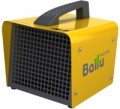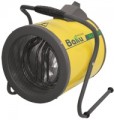Max. thermal output
The highest heating power produced by an industrial heater.
The maximum area that the unit can effectively heat directly depends on this parameter (see below). Even if it is not indicated in the specs, it can be approximately determined from the calculation that for heating 1 m² of a room with a standard ceiling height of 2.5 m and good thermal insulation will require 100 W of thermal power. If the ceiling height is significantly different, then the power required for heating can already be withdrawn from the volume of the room — every 2.5 cubic metres of volume will require the same 100 W (and the volume is found by multiplying the area by the height of the ceiling). There are also more complex formulas for the most accurate calculation, taking into account the degree of thermal insulation, the temperature difference between inside and outside the room, etc.; they can be found in special sources.
Note that in electric models (see "Power supply"), the maximum thermal power, in addition to all of the above, also determines the total power consumption of the unit: the power consumption (see below) cannot be less than the thermal output (usually, it is somewhat higher due to for the removal of part of the energy for the operation of the fan). In devices with a water circuit, the actual thermal output depends on the temperature of the coolant at the inlet and outlet. Therefore, in the characteristics, a certain standard value is usually indicated, and in t...he notes, it is specified for which temperatures it is relevant (for example, 90 ° / 70 °).
Max. heating area
A very conditional parameter that slightly characterizes the purpose by the size of the room. And depending on the height of the ceilings, the layout of the room and the equipment, the actual values may differ significantly. Nevertheless, this item represents the maximum recommended area that the heat gun can effectively heat.
When determining the maximum area, usually, a universal formula is used that is valid for all heaters: 1 m² of floor space in a room with a standard ceiling height of 2.5 m requires 100 W of thermal power. Therefore, if the ceiling height differs markedly from this value, the actual heating area should be recalculated; for more details on scaling, see “Maximum thermal output".
Increase in air temperature (ΔT)
This parameter describes the difference between the air temperature at the inlet to the heater and the outlet temperature — in other words, by how many degrees the air temperature rises when passing through the unit. The higher ΔT, the hotter the outgoing air will be and the more attentively it is necessary to observe safety measures (do not place the device near flammable and heat-sensitive materials, prevent people from being in the immediate vicinity of the gun exit, etc.).
Supply voltage
The nominal supply voltage required for the operation of the industrial heater.
—
Single-phase (400 V). Powered by standard household mains, in other words, ordinary sockets. This option is the most versatile: 230 V can be found almost everywhere where electricity is connected. At the same time, such power is not suitable for devices that consume more than 5 kW — in such cases, a special connection format will be required, and in general, the power of the units cannot be particularly high. Therefore, among electric industrial heaters (see "Power supply"), an operating voltage of 230 V is typical for entry-level models. But among other varieties, it is very common: the power consumption of the fan and auxiliary electronics is usually small, and 230 V is quite enough for it.
—
Three-phase (400 V). This standard is common in industrial equipment with high power consumption, and industrial heaters are no exception: an operating voltage of 400 V. Usually, it indicates the high power and performance of an electric model. At the same time, this option is practically not used in units with other types of power supply — 230 V is enough for their operation (see above). In addition, note that a three-phase connection is far from being present wherever there is an electrical mains. Therefore, when buying an industrial heater for 400 V, you should make sure in advance that there is power for it at
...the planned installation site.
— Single-phase/three-phase (230 / 400 V). Universal models are capable of using both types of networks described above. Usually, these are electrical units of relatively low power — otherwise, they could not work normally with 230 V networks. However, even for them, a three-phase connection may be useful, because 400 V mains are much better at handling loads of several kilowatts, and the ability to work with single-phase power insures against situations where three phases are not nearby.Rated current
The current consumed by the heat gun during normal operation. This parameter is useful primarily for assessing the load on the mains that occurs during the operation of the unit and organizing the appropriate connection. In particular, the rated current of the fuse installed in the connection circuit cannot be lower than the total rated current of the connected load — otherwise, the power will be turned off. Heat guns (primarily electric, see "Power supply") are quite high consumption consumers in terms of current.
Power consumption
The power consumed by the electrical components of the industrial heater during operation.
This parameter allows, first of all, to assess the load on the power grid and the suitability of the available power for the normal operation of the unit. It is relevant for all types of modern industrial heaters (see "Power supply"). However, it is worth noting that in some electric models, the power consumption is indicated for the ventilation mode. In this mode, the heating element is not activated, and the power consumption is extremely low — a few tens of watts. In such cases, the total power can be estimated from the maximum thermal output (see above) — in electrical models, these parameters practically do not differ from each other.
Heating element
—
Open coil. The simplest type of heater for electric industrial heaters (see "Power supply"): a high-resistance metal coil that heats up when an electric current passes through it. open coil heaters are inexpensive, heat up quickly, provide a large increase in air temperature (see above) and generally have good efficiency. At the same time, dust or other contaminants can get on an open heater, which leads to unpleasant odours, intense heating dries the air, and the heating element is characterized by an increased fire hazard and has a relatively short service life (in other words, it burns out quite quickly from contact) with air, moisture and pollution).
—
Tubular heater. The main element of such devices is also an electric heater (see above), but in this case, it is not installed openly but is enclosed in a metal tube filled with a heat-conducting insulating material (for example, quartz sand). Heating elements heat up somewhat more slowly than open coils, and their heating temperature is lower. However, this type of heater is considered more advanced — primarily because the protected heater is safer and more durable. In addition, a low operating temperature also has its advantages — a large temperature difference at the inlet and outlet is not always convenient, and there are fewer unpleasant odours when the heating element is contaminated.
—
Ceramic.
...The most advanced type of heaters for electric type industrial heaters. Usually, such elements have the form of a series of plates made of special ceramics with high thermal conductivity. Due to this, it is possible to ensure high heat transfer efficiency at low operating temperatures, due to which ceramic heaters do not burn dust and dirt, practically do not create unpleasant odours, and the effect of drying the air from them is not so noticeable. On the other hand, such equipment is expensive.
— Heat exchanger. A type of heater that is used only in water models (see "Power supply") and diesel units of indirect heating (see "Type of diesel heater"). In the first case, the heat exchanger is a circuit through which heated water or other coolant passes, in the second — a combustion chamber of a special design. Anyway, the air passing through the heater is heated by contact with the outer walls of the heat exchanger. To increase the contact area and increase the heating efficiency, these walls often have a complex shape — with ribbed protrusions, plates, etc.
— IR plate. Specially designed plate that transfers heat primarily by infrared radiation. For several technical reasons, it is used only in diesel industrial heaters, and, unlike traditional units, these models do not have a fan. It is because IR radiation does not heat the air, but directly the objects that are under it, so there is no need to provide air circulation. IR heaters are convenient in cases where you need to heat only a relatively small area in a large room; in addition, they can be effectively used even outdoors, where the heat from traditional industrial heaters would simply be dissipated into the atmosphere.Airflow
The maximum amount of air that an industrial heater can pass through itself in a certain time.
This parameter is associated with an increase in air temperature (see above): at constant power, higher performance usually corresponds to a smaller temperature difference. Accordingly, a more efficient industrial heater will heat the entire volume of the room faster, but the heating temperature will be lower. So, it is worth choosing according to this parameter, taking into account what is more important for you — a large temperature difference or a high heating rate.
Power adjustment
The method of adjusting the heating power provided in the design of the heat gun.
- Stepped. Step adjustment assumes the presence of several fixed power values, between which switching is carried out during the tuning process. The accuracy of such a setting is worse than that of a stepless one (see below), even in cases where there are quite a lot of fixed values. At the same time, perfect accuracy is far from always required, and setting a specific value is easier than selecting the position of the regulator with stepless adjustment.
-
Stepless. Stepless systems include adjustment systems that do not have fixed steps and allow you to set the power value in any range from minimum to maximum. Due to this, this setting is extremely accurate, although in some cases it is not as convenient as the stepped one described above.

